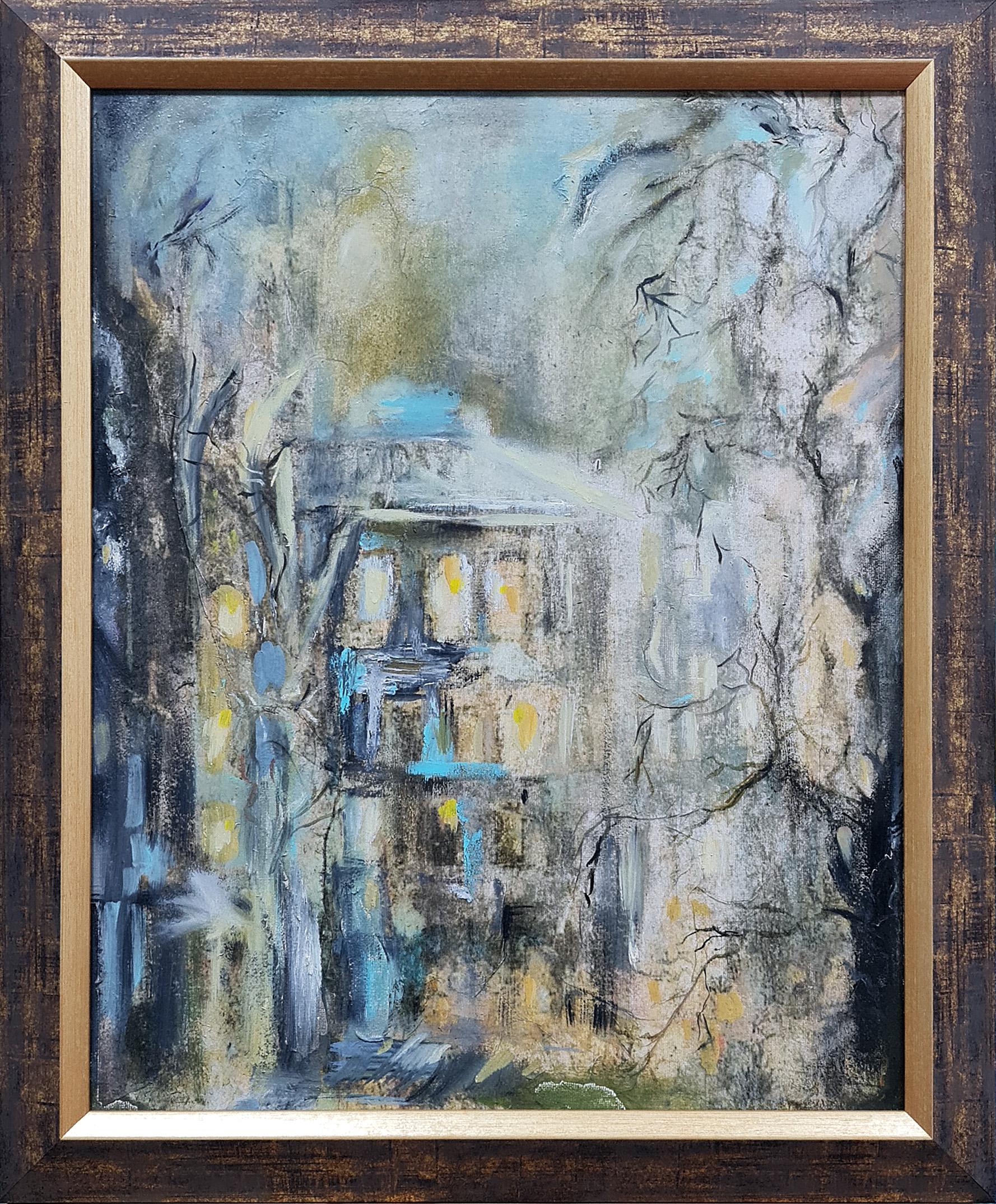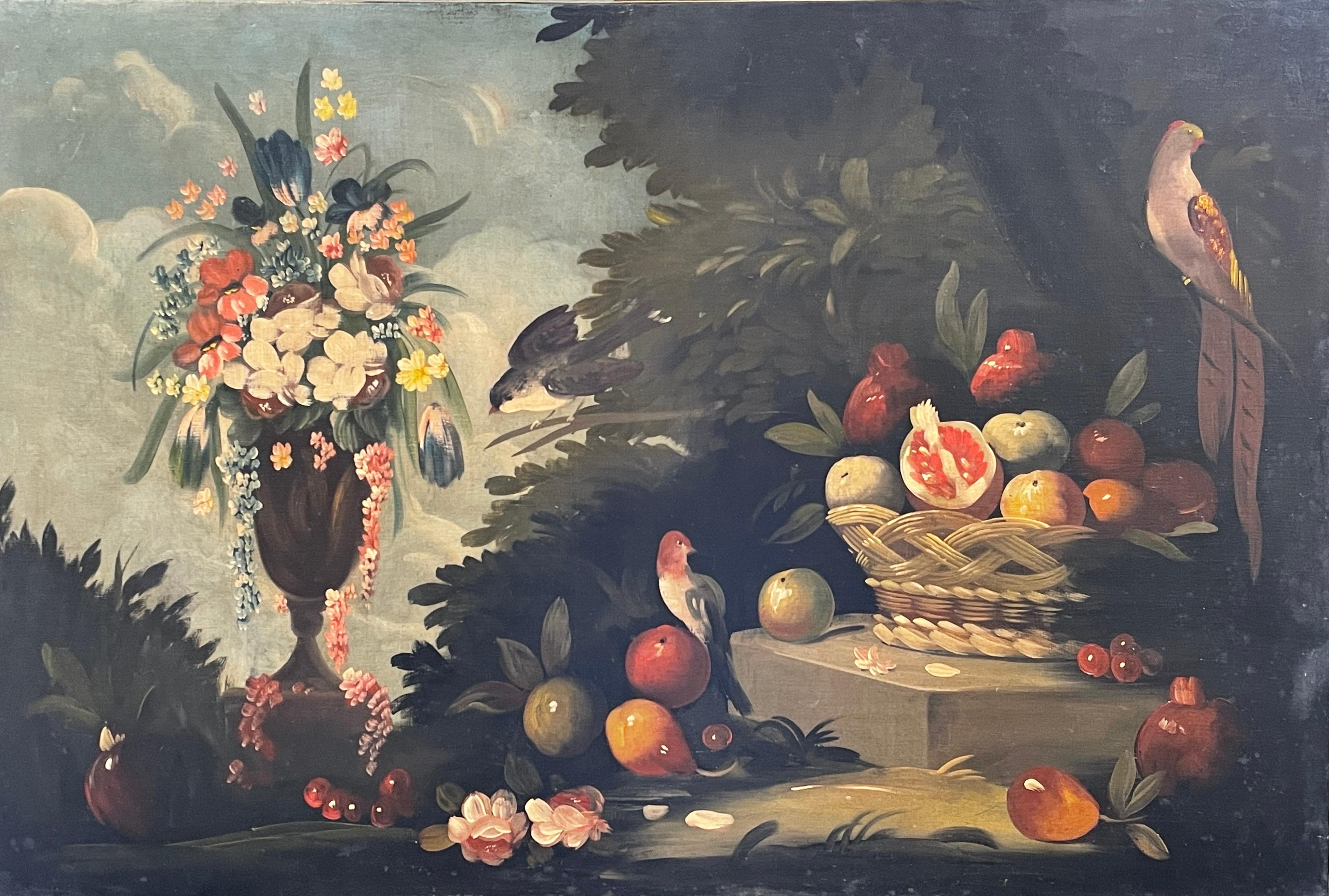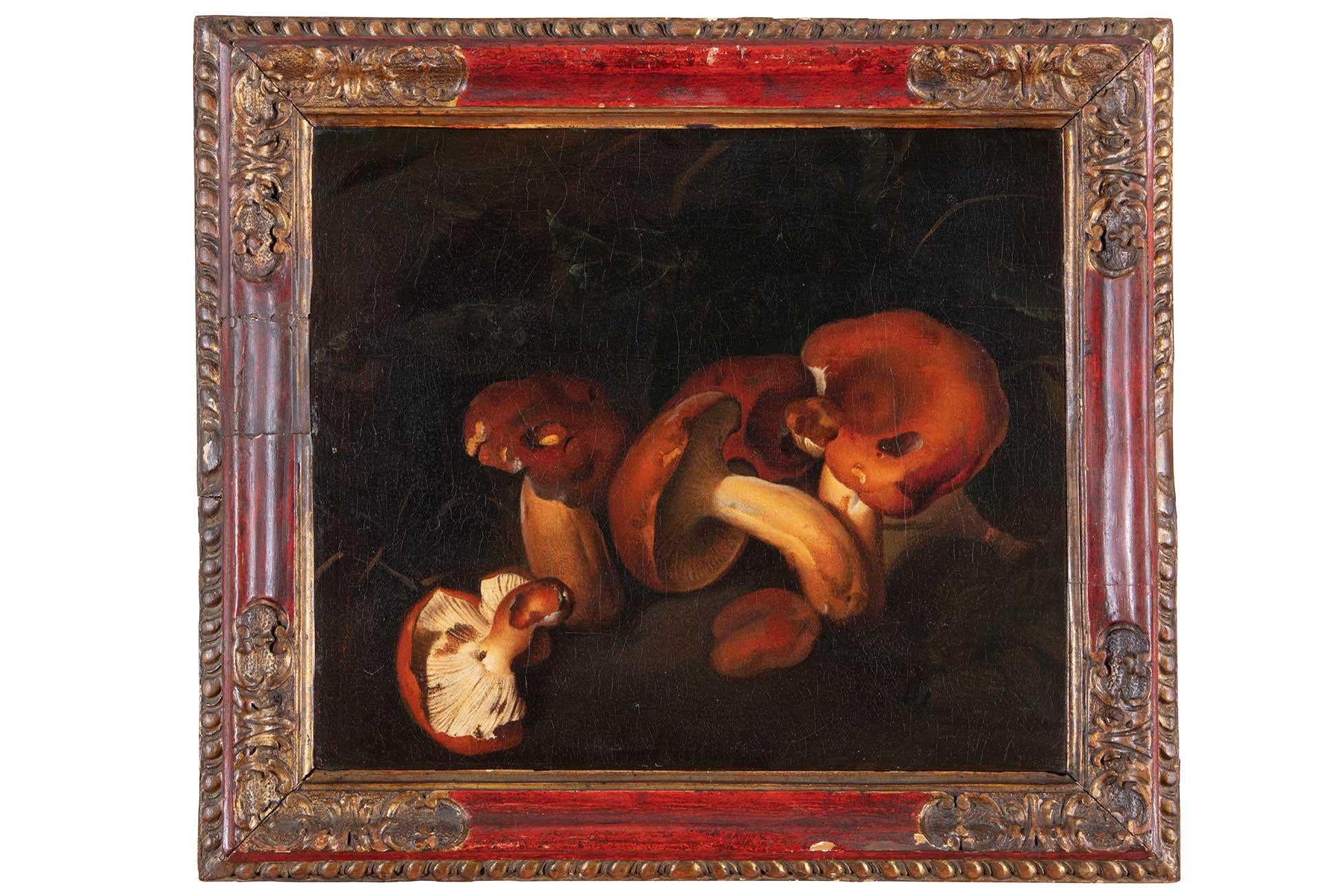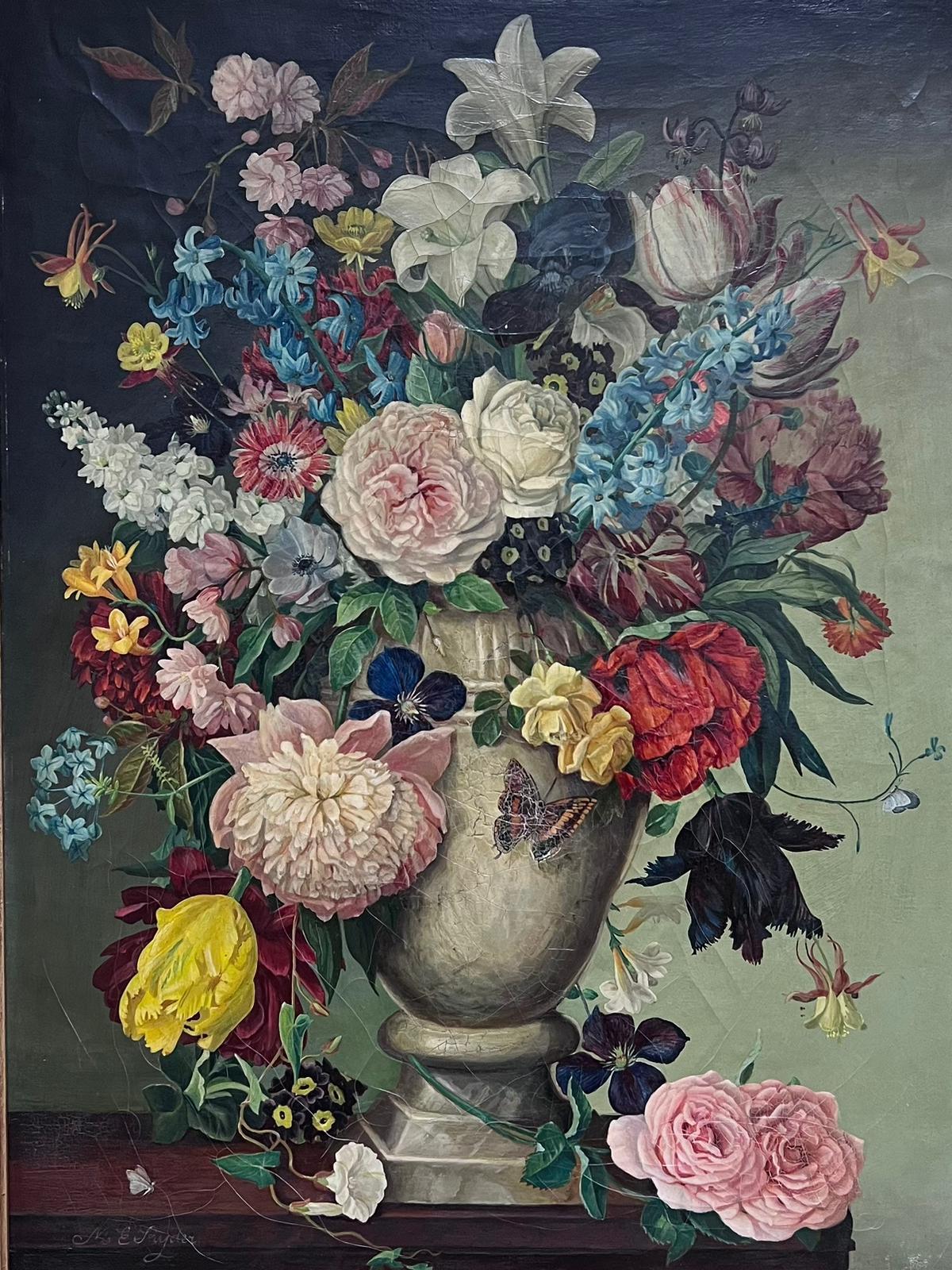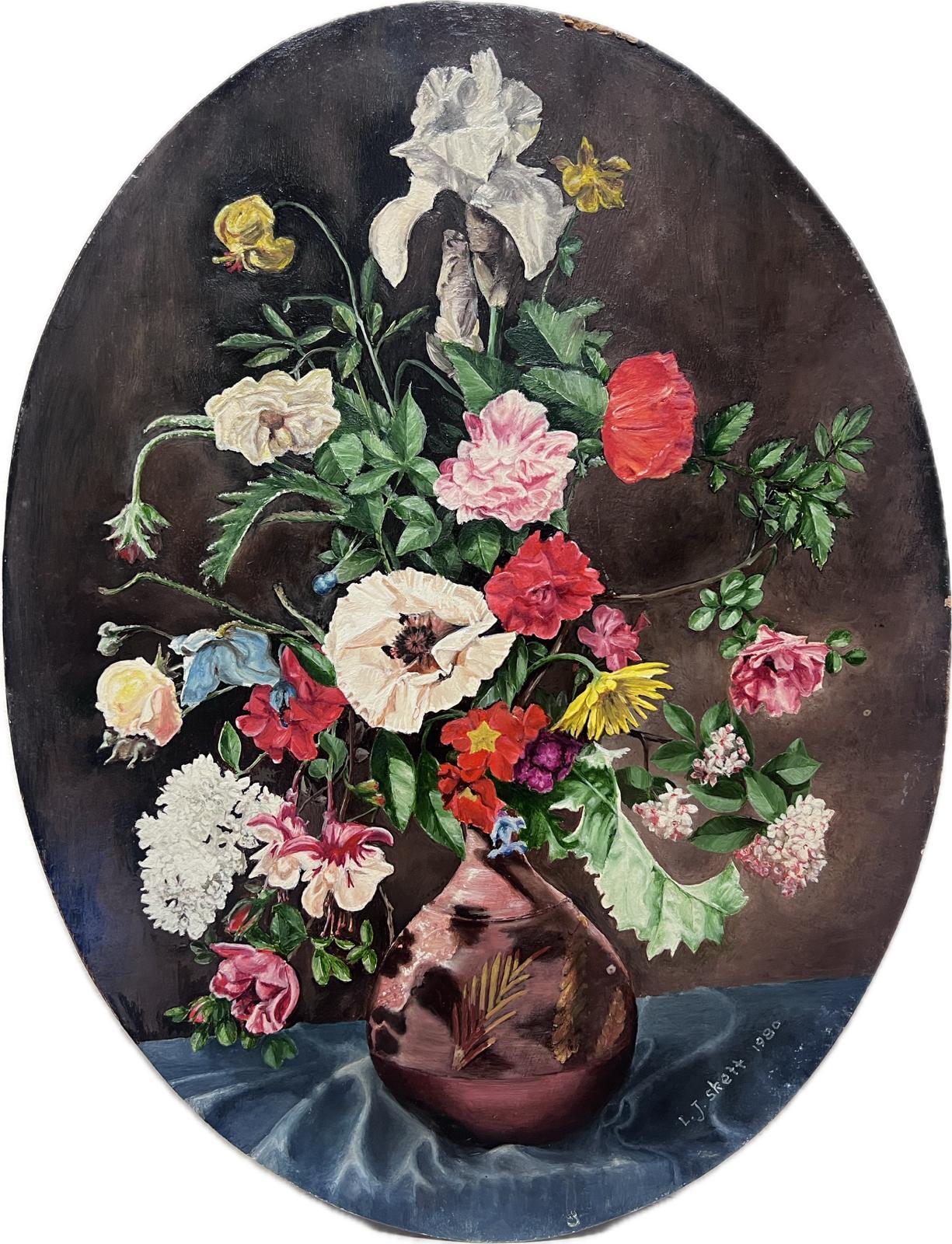Items Similar to Flower Garland Virgin Paint Oil on canvas Old master 17th Century Italy
Want more images or videos?
Request additional images or videos from the seller
1 of 17
Flower Garland Virgin Paint Oil on canvas Old master 17th Century Italy1640- 1680
1640- 1680
About the Item
Giovanni Stanchi (Rome 1608 - 1675) or Niccolò Stanchi (Rome 1623 - 1690), workshop of
GARLAND OF FLOWERS WITH PORTRAIT OF THE VIRGIN
Rome, First half of the Seventeenth century
oil on canvas, cm. 73 x 59
framed cm. 98 x 82
The examined painting is to be ascribed to the production of Giovanni Stanchi's atelier (Rome 1608 - 1675); The 'Stanchi' (the founder Giovanni, together with the brothers Niccolò and Angelo) constituted one of the most fervent still life workshops in Baroque Rome starting from 1630, sought after by the most important families of the aristocracy, from the Colonna, to the Chigi, to the Rospigliosi , and present since the end of the century in the Medici collections.
Their production, extremely varied in type but coherently stylistic, can be subdivided according to the subjects proposed: first of all the garlands, of which the proposed canvas represents an example of quality, linked to the Flemish model made famous in Rome by Daniel Seghers, and probably largely related to Giovanni; The style of the work may well approach the works of Niccolò, active in Rome for almost the entire seventeenth century, younger brother and owner of the workshop after Giovanni's death.
As for the portrait of the Virgin at the center of the garland, it must be said that, in this type of composition, the figures were often entrusted to a specialized painter, different from the painters of flowers. Carlo Maratta, for example, often collaborated with some important workshops, including Stanchi and Mario Nuzzi, completing their floral compositions with his religious subjects (see details).
This is the case, by way of example, of the magnificent mirrors performed by Giovanni Stanchi in 1670 for the gallery of Palazzo Colonna in collaboration with Carlo Maratta (Garland of flowers with four cherubs; and Vase of flowers with five cherubs), in competition with Mario dei Fiori, author of the other two; as for Nicolò, the younger brother who owned the shop after Giovanni's death, the mirrors in the Borghese palace, executed in 1675 in collaboration with Ciro Ferri.
CONSERVATION Our flower composition stands out for its bright colors and excellent preservation
Like all our objects, the work is sold with a certificate of photographic authenticity in accordance with the law.We handle and organize the transport of the purchased works, both for Italy and abroad, through professional and insured carriers.
Contact us for any information, we will be happy to answer you.
- Creation Year:1640- 1680
- Dimensions:Height: 38.59 in (98 cm)Width: 32.29 in (82 cm)
- Medium:
- Movement & Style:
- Circle Of:Giovanni Stanchi (1608 - 1675, Italian)
- Period:
- Condition:
- Gallery Location:Riva del Garda, IT
- Reference Number:1stDibs: LU98815507102
About the Seller
4.8
Platinum Seller
These expertly vetted sellers are 1stDibs' most experienced sellers and are rated highest by our customers.
Established in 2017
1stDibs seller since 2018
198 sales on 1stDibs
Typical response time: <1 hour
- ShippingRetrieving quote...Ships From: Riva del Garda, Italy
- Return PolicyA return for this item may be initiated within 7 days of delivery.
Auctions on 1stDibs
Our timed auctions are an opportunity to bid on extraordinary design. We do not charge a Buyer's Premium and shipping is facilitated by 1stDibs and/or the seller. Plus, all auction purchases are covered by our comprehensive Buyer Protection. Learn More
More From This SellerView All
- Angels Flower Garzi Paint Oil on canvas Old master 17/18th Century Italian ArtBy Luigi Garzi (Pistoia 1638– Rome1721)Located in Riva del Garda, ITRoman school of the early 18th century Luigi Garzi (Pistoia 1638– Rome1721) attributed Still life of fruit supported by three angels Oil on oval canvas 116 x 91 cm., Framed 140 x 119 cm. Authentication on a photograph by Prof Giancarlo Sestieri, who attributes the work to the sphere of Luigi Garzi This magnificent canvas, depicting a sumptuous composition of fruit supported by three prosperous winged cherubs, from which comes a parchment bearing the Latin expression "Amor est vitae essentia", is to be placed in the production of a Roman author active between the second half of XVII century and the first of the following century. The iconography that sees represented cherubs with fruit or flowers is frequent in the Baroque period, especially in the Roman area, starting from the 1600s, with that particular depictional tendency aimed at illusionistic and frivolous images, to a type of paintings or frescoes of strong value decorative, intended for the private context and depicting jubilation of cherubs, angels or cherubs, and of which our canvas represents a perfect example. We can recall, among the most illustrious iconographic precedents, the elegant mirrors painted by Mario Nuzzi and Carlo Maratta that adorn the hall of Palazzo Colonna in Rome, and again the canvas preserved in the Rouen museum and the similar ones in Palazzo Chigi in Ariccia, with the collaboration for the figurative parts of Filippo Lauri. The commercial and furnishing success of similar works is also testified by authors such as Guglielmo Cortese known as Borgognone (1628 - 1679), Franz Werner Von Tamm (1658 - 1724), Giovan Battista Gaulli (1639 - 1709), Giovanni Paolo Castelli known as Spadino (Rome 1650 - 1740) and the aforementioned Carlo Maratta (1625 - 1713) The work, studied by Giancarlo Sestieri, was brought closer to the sphere of the eclectic Pistoian painter Luigi Garzi, one of the protagonists of Roman painting in the decades of transition between the seventeenth and eighteenth centuries. In our painting we can find the typical elements of his painting: the soft and delicately chiaroscuro light, the sculptural classicism of the figures as well as the stupendous luministic and chromatic effects. Luigi Garzi's training and artistic activity took place in the Eternal City and he was in effect a Roman artist. He moved to Rome from Pistoia, his hometown at a very young age, and joined the atelier of Andrea Sacchi, who directed his studies towards classicism, comparing himself with the works of Raphael, Domenichino and Nicolas Poussin, but also with the Emilian one. , with particular attention to the school of Guido Reni. But the Emilian examples were undoubtedly preceded, particularly by Giovani Lanfranco, who modeled his taste and style, together with a modulated cortonism, while those pre-eighteenth-century sensibilities are due to the lesson of Carlo Maratta. However, there is no doubt that the painter oriented his personality without ever bowing to imitation, reaching a refined elegance and autonomy of language, as the canvas in question clearly demonstrates in which the different influences find a refined amalgamation in perfect harmony with the baroque evolution between the seventeenth and eighteenth centuries, indicating a dating to its earliest maturity. These attitudes led the painter to obtain awards and prestigious commissions as soon as possible, such as the frescoes of Palazzo Borghese...Category
Late 17th Century Old Masters Paintings
MaterialsOil
- Flowers Paint Oil on canvas Old master 17th Century Italy Still-life ArtLocated in Riva del Garda, ITMaster of the Grotesque Vase (active in Rome and Naples in the first quarter of the 17th century) Still life of flowers in a classic vase oil on canvas 66 x 51 cm, In frame cm. 82 x...Category
17th Century Old Masters Paintings
MaterialsOil
- De Wit Flowers Still life Paint Oil on canvas 18th Century Flemish Cupids ArtLocated in Riva del Garda, ITJacob De Wit (Amsterdam, 1695 - 1754) attributable/ workshop Pair of Cupids with Garland of Flowers Oil on canvas 91 x 103 cm. - Framed 104 x 115 cm. Provenance: Christie's (London, Old master Painting 12.12.1996) lot 82 This magnificent composition depicts two cupids holding a garland of flowers, placed on a fine architecture with bas-reliefs and masks, presumably the top of a fountain. One of the two cupids sympathetically holds a part of it with his hands, while his head turns towards the viewer; the second cupid, on the other hand, must have clumsily broken the thread holding its end, and is sitting sullenly with a torch and a tear streaking his chubby cheek. The work, given its stylistic features and compositional taste, can be attributed to the Flemish artist Jacob de Wit (Amsterdam, 1695 - 1754), or to an artist from his workshop, with his typical triumphal and opulent style, which reveals clear influences from Rubens and Van Dijck, but also from Gerard de Lairesse...Category
18th Century Old Masters Paintings
MaterialsOil
- Still Life Flowers Garden Lavagna Paint 17/18th Century Oil on canvas ItalianLocated in Riva del Garda, ITStill Life with Flowers in a Garden (1), Francesco Lavagna (Naples, 1684 - 1724) Francesco Lavagna (Naples, 1684 - 1724) (LINK) Still Life with Flower Arrangements in a Garden (1) ...Category
17th Century Old Masters Paintings
MaterialsOil
- Still-Life Flower Landscape Castelli Paint Oil on canvas Old master Italian artBy Giovanni Paolo Castelli, known as Spadino (Rome, 1659 - 1730)Located in Riva del Garda, ITStill life in a landscape with fruit and game Work of the late Roman Baroque of the late seventeenth / eaarly eighteenth century attributable to Giovanni Paolo Castelli, known as Spadino (Rome, 1659 - 1730) oil on canvas 62 x 76 cm., Framed 90 x 109 cm. An open-air setting, with a hilly landscape gash that opens into the distance in the central part, surrounds our beautiful canvas, which showcases a rich selection of game and fruit, arranged in the foreground near the point of view of the observer, occupying a large part of the visual field with their bright and festive colors. The style and quality of the work, like the pictorial technique of this still life, characterized by subtle luminous vibrations and a lively chroma, make it attributable to the Roman Giovanni Paolo Castelli, known as Lo Spadino (Rome, 1659 - 1730), one of the most important specialists of this pictorial genre of late Baroque Rome, which had a very successful career between the 17th and 18th centuries. Analyzing the rich and heterogeneous catalog of the Roman master, in fact, our canvas can be included among his rare works which, alongside a selection of fruit - among which stand out large melons, ripe figs, dark grapes and plums - we see a game advert, presumably as requested by a patron who loves hunting. Next to various birds, spoils of a profitable hunting trip, there is also a small green woodpecker, with the characteristic red spot on the head, and a nice rodent that terminates from behind the trunk. The painter abandons himself to a skilful and brilliant chromatic texture of the surfaces, through a pictorial material rendered with exceptional vibration in its luminous and 'tactile' body, fully respecting the taste of the full Roman Baroque. The quality appears excellent, distinguished by a skilful and brilliant chromatic texture of the surfaces, which appear almost vibrant thanks to a skilful drafting of the pictorial material. Inevitable and evident are the Flemish suggestions, which had influenced the Roman Baroque still life, in particular the work of Abraham Brueghel...Category
Late 17th Century Old Masters Paintings
MaterialsOil
- Flower Still-life Virgin Trevisani Stanchi Paint Oil on canvas 17/18th CenturyBy Francesco Trevisani (Capodistria 1656 - Rome 1746)Located in Riva del Garda, ITFlower garland with a portrait of the Virgin Francesco Trevisani (Capodistria 1656 - Rome 1746) and Niccolò Stanchi (Rome 1623 - 1690), attributable Oil on canvas 66 x 49 cm. - In f...Category
18th Century Old Masters Still-life Paintings
MaterialsOil
You May Also Like
- RED GRAPES, RED WINELocated in Santa Fe, NMRED GRAPES, RED WINE Aleksei Kreydun studied the Old Masters and has revived their long lost techniques, building up multiple layers of oil paint and lacque...Category
Early 2000s Old Masters Still-life Paintings
MaterialsOil
- Still Life with Squash, Gourds, Stoneware, and a Basket with Fruit and CheeseLocated in New York, NYProvenance: Selma Herringman, New York, ca. 1955-2013; thence by descent to: Private Collection, New York, 2013-2020 This seventeenth century Spanish still-life of a laden table, known as a bodegón, stands out for its dramatic lighting and for the detailed description of each object. The artist’s confident use of chiaroscuro enables the sliced-open squash in the left foreground to appear as if emerging out of the darkness and projecting towards the viewer. The light source emanates from the upper left, illuminating the array, and its strength is made apparent by the reflections on the pitcher, pot, and the fruit in the basket. Visible brush strokes accentuate the vegetables’ rough surfaces and delicate interiors. Although the painter of this striking work remains unknown, it is a characteristic example of the pioneering Spanish still-lifes of the baroque period, which brought inanimate objects alive on canvas. In our painting, the knife and the large yellow squash boldly protrude off the table. Balancing objects on the edge of a table was a clever way for still-life painters to emphasize the three-dimensionality of the objects depicted, as well a way to lend a sense of drama to an otherwise static image. The knife here teeters on the edge, appearing as if it might fall off the table and out of the painting at any moment. The shape and consistency of the squash at left is brilliantly conveyed through the light brush strokes that define the vegetable’s fleshy and feathery interior. The smaller gourds—gathered together in a pile—are shrouded partly in darkness and stand out for their rugged, bumpy exterior. The stoneware has a brassy glaze, and the earthy tones of the vessels are carefully modulated by their interaction with the light and shadow that falls across them. The artist has cleverly arranged the still-life in a V-shaped composition, with a triangular slice of cheese standing upright, serving as its pinnacle. Independent still-lifes only became an important pictorial genre in the first years of the seventeenth century. In Italy, and particularly through the revolutionary works of Caravaggio, painted objects became carriers of meaning, and their depiction and arrangement the province of serious artistic scrutiny. Caravaggio famously asserted that it was equally difficult to paint a still-life as it was to paint figures, and the elevation of this new art form would have profound consequences to the present day. In Spain Juan Sanchez Cotan...Category
17th Century Old Masters Still-life Paintings
MaterialsCanvas, Oil
- Still Life of Flowers in a Vase late Victorian 19th Century Hippolyte DelanoyBy Hippolyte Pierre DelanoyLocated in Lincoln, GBHippolyte Pierre Delanoy (1849-1899) A Study of Flowers 1874 Signed and Dated, Oil on Canvas, 57 x 49cm Delanoy was born in Glasgow, of French Parents and was the brother of painter...Category
Late 19th Century Old Masters Still-life Paintings
MaterialsOil
- Still lifeLocated in Genève, GEWork on canvas Black wooden frame 37 x 45 x 3 cmCategory
Mid-19th Century Old Masters Still-life Paintings
MaterialsOil
- Still Life of Flowers in vase on Ledge - Dutch 17thC Old Master art oil paintingLocated in London, GBThis stunning 17th century Dutch Old Master Golden Age floral oil painting is by noted Dutch artist Simon Pietersz Verelst. The full attribution...Category
1670s Old Masters Still-life Paintings
MaterialsOil
- Flowers on WhiteBy Martin MooneyLocated in Belfast, GBFlowers on White Oil on Board 61 x 50.8 cm 24 x 20 in Regarded as one of Ireland’s most accomplished fine art painters, Martin Mooney was born in 1960, in Belfast, Northern Ireland....Category
2010s Old Masters Still-life Paintings
MaterialsOil
Recently Viewed
View AllMore Ways To Browse
Antique Flower Art
All Master Paintings
Flower Oil Paint
Old Weller Antique
Old Wellers Antique
Old Flower
Canvas Painted Flowers
Old Paintings Oil Canvas
Old Italian Antique
Italian Master Painting
Old Famous Art
Old Masters Framed
Old Masters Painters
Old Master Style
Italian Masters Oil
Old Masters Italy
Paintings Italian Old
Oil On Canvas Old Masters
